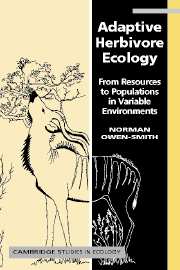Book contents
- Frontmatter
- Contents
- Acknowledgements
- Acronym and symbol conventions
- 1 Conceptual origins : variability in time and space
- 2 Consumer–resource models : theory and formulation
- 3 Resource abundance : intake response and time frames
- 4 Resource distribution : patch scales and depletion
- 5 Resource quality : nutritional gain and diet choice
- 6 Resource constraints : physiological capacities and costs
- 7 Resource allocation : growth, storage and reproduction
- 8 Resource production : regeneration and attrition
- 9 Resource competition : exploitation and density dependence
- 10 Resource-dependent mortality : nutrition, predation and demography
- 11 Habitat suitability : resource components and stocking densities
- 12 Resource partitioning : competition and coexistence
- 13 Population dynamics : resource basis for instability
- 14 An adaptive resource ecology : foundation and prospects
- References
- Index
5 - Resource quality : nutritional gain and diet choice
Published online by Cambridge University Press: 04 February 2011
- Frontmatter
- Contents
- Acknowledgements
- Acronym and symbol conventions
- 1 Conceptual origins : variability in time and space
- 2 Consumer–resource models : theory and formulation
- 3 Resource abundance : intake response and time frames
- 4 Resource distribution : patch scales and depletion
- 5 Resource quality : nutritional gain and diet choice
- 6 Resource constraints : physiological capacities and costs
- 7 Resource allocation : growth, storage and reproduction
- 8 Resource production : regeneration and attrition
- 9 Resource competition : exploitation and density dependence
- 10 Resource-dependent mortality : nutrition, predation and demography
- 11 Habitat suitability : resource components and stocking densities
- 12 Resource partitioning : competition and coexistence
- 13 Population dynamics : resource basis for instability
- 14 An adaptive resource ecology : foundation and prospects
- References
- Index
Summary
For herbivores, the nutritional gain depends not only on the rate of food intake, but also on the quality of the material consumed. Accordingly, in this chapter the focus shifts from the intake response to the biomass gain response, represented by the function G in Equation 2.14, and hence to factors determining the value of the conversion coefficient c from plant to herbivore biomass.
The nutritional quality of herbage consumed is governed by its composition, firstly in terms of the proportion of cell wall fibre relative to cell contents, and secondly by concentrations of protein, soluble carbohydrates, mineral elements and other nutrients in the cell contents. These factors, as well as the composition of the cell wall, particularly its degree of lignification, determine the potential nutritional yield in the form of metabolizable energy and material substrates. However, the cell wall content also slows down the rate of digestive processing, restricting the rate at which these energizing and material nutrients become available, particularly for ruminants. In addition, many plant species contain various secondary chemicals, which may function as potential toxins, or impede digestion in various ways, reducing nutrient availability. Diet selection thus becomes largely a matter of balancing different nutritional benefits against various costs and rate restrictions. Immediate gains may need to be balanced against longer-term consequences. Quality as governed by nutritional yields must be traded against quantity as determined by the rate of intake obtained, over different time frames.
- Type
- Chapter
- Information
- Adaptive Herbivore EcologyFrom Resources to Populations in Variable Environments, pp. 85 - 109Publisher: Cambridge University PressPrint publication year: 2002



